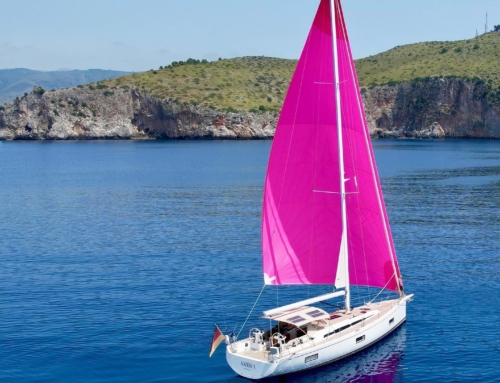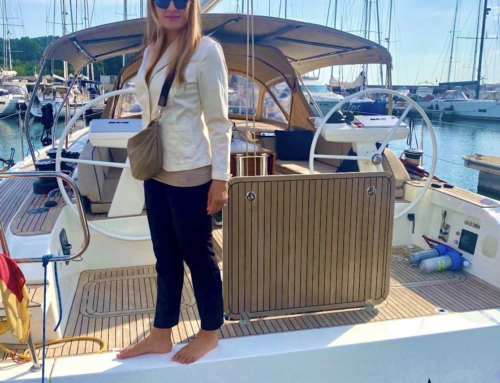
When it comes to the freedom and flexibility of sailing, there’s nothing quite like it. The ability to drop anchor and stay away from the harbor for extended periods is a true luxury. However, achieving this level of independence from essentials like diesel, water, and electricity is a sailor’s challenge. While sailors who frequent different ports may not be bothered by these concerns, for those embarking on long-distance bluewater sailing, self-sufficiency becomes paramount. In this article we share our experience using different systems on SY Ambra including power and fuel consumption, solar power and lithium batteries.
In addition we cover alternative systems, please click below for more information:
Power Consumptions and Demand
Today sailors install and enjoy all kind of luxury and additional power hungry systems. We all like a cool drink, the benefits of a dish washer or washing machine, 110/220V power plugs to charge Laptops, tablets or communication devices such as Starlink. To dimension the onboard energy system correctly, it’s crucial to assess the energy consumption of all appliances and devices on board. You need to make a list of all devices on board, the number of hours you are going to use them while sailing or on anchor to estimate the average power consumption. This will help you to determine your average power consumption and the size of your batteries and generators.
Here is a list of appliances you should look at:
Modern technology, like LED lighting, allows for significant energy savings. For instance, a 4-watt LED tricolor light at 24 volts consumes only around 0.2 amperes per hour, in stark contrast to three navigation lights, which could draw 3 amperes per hour along with the possibility of additional deck lights. Instruments, while sailing your plotter (we switched one system off during our Atlantic crossing) and the autopilot will consume most of the electricity. In terms of communication, your VHF radio in receiving mode and AIS is very little but Starlink will use over 60-130W per hour. The refrigerator runs almost 24h in warmer climates such as the Caribbean and the Med during hot summer month. Our watermaker runs on 24Volt and generates around 100L fresh water per hour. Factors such as water consumption, bathing habits, and toilet flushing determine the water demand. You should be able to run all the devices above by lithium batteries and recharge the batteries with alternative generators.
The aircon, washing machine and induction cooker might need so much power that you have to consider a Genset to run the devices outside marinas. We used our aircon system mainly in marinas because you tend to have less wind and ample shore power. While on anchor we might use the aircon only for a short period to cool down the cabin and reduce humidity before we go to bed.
Managing Diesel Consumption
The first step towards independence is managing your diesel consumption. The amount of diesel you can carry is limited by the size of your fuel tanks. Beyond that, it all comes down to consumption. Many sailors aim to sail as much as possible, especially on longer routes, relying on the wind whenever they can. However, diesel is often still needed to generate electricity through alternators on the engine or generators. Having both options on board provides flexibility and a backup in case one system fails. In addition we installed two alternators on our diesel engine. One system will charge with 12V the starter battery and a second high power alternator running 24V/110A will charge the lithium service batteries.
Another option would be the Integral system creating 48V high power alternator with a power management system to charge batteries or service 110/220V appliances. More information under https://integrelsolutions.com/
The system is less expensive than a genset, either to install (no additional through-hulls for the cooling circuit and less maintenance.
Alternative Energy Sources the way of the future
In the ever-evolving world of sailing vessels, innovation has led to a revolution in the way we power our journeys. Gone are the days when ships relied solely on fossil fuels for propulsion. Instead, sailors have turned to alternative energy sources, not just to navigate the open waters, but to do so in an eco-friendly and sustainable manner.

Harnessing the Power of Solar Energy
In the realm of energy management, harnessing solar power has proven to be highly effective, not just in the Mediterranean but also in the challenging waters of the East and North Seas. Solar panels can be a game-changer, offsetting your daily power needs, such as running the refrigerator, lighting, navigation devices, and autopilot.
To maximize your solar power potential, consider installing solar panels on your bimini. We integrated 480 Watt Peak solar panels on our bimini. While the theoretical output is 480 watts at 24 volts (equivalent to 20 amperes), real-world conditions may vary. These panels, designed for offshore use, attach easily to the bimini with LOXX fasteners, allowing for effortless removal. Todays solar panel include a unique wiring design ensures that even if one panel is shaded, the others continue to operate at full capacity, a crucial feature given the constant movement of a yacht at anchor or while sailing. In addition we use a 240 watt peak solar panel while on anchor. We unfold the panel on our deck in front of the spray hood for additional power. The total capacity is 720 watt peak and keeps us power neutral.
The advantages of solar power for sailors are numerous:
– Availability: Solar power is continuously available during the day (though not at night).
– Minimal Disruption: Unlike wind generators, solar panels are quiet and unobtrusive.
– Cooling Effect: Panels on the bimini also benefit from wind cooling, preventing overheating and loss of efficiency.

The Lithium Battery Advantage
When it comes to storing the energy generated, we’ve opted for 24-volt lithium batteries. These batteries offer several advantages:
– Rapid Charging: Lithium batteries can accept a high charge rate, with our motor’s high-output alternator capable of delivering over 100 amperes. This significantly reduces charging times. Solar panels also charge faster and longer in bulk mode compared to lead/AGM batteries, which taper off their charging rates earlier.
– Deeper Discharge: Lithium batteries can be discharged much deeper than traditional lead/AGM batteries, allowing us to utilize nearly 100% of their capacity. In contrast, lead-acid batteries should not be discharged beyond 50%.
– Higher Energy Density: Lithium batteries offer more energy capacity for their size and weight, providing greater capacity per unit area.
– Extended Lifespan: With over 3000 charge cycles, lithium batteries have a longer lifespan than traditional batteries.
While the initial cost of lithium batteries is higher, their long-term benefits, including more charge cycles and the ability to use nearly 100% of their capacity, can offset the upfront expense. However, it’s important to note that lithium batteries do require more complex wiring and battery management. Finding replacements in remote locations can also be challenging.
SY Ambra – Powering Appliances and Amenities
Our yacht is equipped with 400Ah/24V lithium batteries, providing power not only for essential systems but also for luxury amenities. Our 24-volt watermaker, capable of producing approximately 100 liters per hour, ensures we have a reliable source of fresh water. The onboard generator not only charges the batteries but also supplies 220 volts with an impressive 8KW output. This luxury feature allows us to use the air conditioning or dehumidifier when needed. Additionally, for other 220-volt appliances like charging phones or laptops, we have an inverter onboard that converts 24 volts from the lithium batteries into 220 volts, eliminating the need to start the generator for small power needs.
The Ultimate Energy System
In conclusion, the combination of lithium batteries, solar power, and a robust supplementary alternator creates an optimal energy system for yachts. While the initial investment may be higher, the advantages in terms of energy efficiency, sustainability, and convenience are undeniable. When planning your yacht’s energy system, it’s essential to create a list of all your power-consuming devices and calculate the battery capacity needed. Additionally, consider factors like crew size and water usage, as these variables significantly impact energy requirements. Whether you’re cruising near the coast or exploring remote islands in the South Pacific, the right energy management system can enhance your sailing experience while reducing your environmental footprint.
Sailing vessels powered by solar, wind, hydrokinetic energy, and biofuels are becoming the norm rather than the exception. This transition aligns with the global commitment to reduce greenhouse gas emissions and protect our oceans. It’s clear that the future of sailing is intertwined with the future of our planet.
So, whether you’re a seasoned sailor or someone considering a voyage on the open seas, remember that the power of alternative energy sources can make your journey not only memorable but also environmentally responsible.
So, hoist your sails and set a course for a greener, more sustainable future!




Hinterlasse einen Kommentar